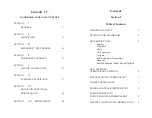
THRUSH AIRCRAFT, INC – MODEL S2R-R1340
AIRCRAFT MAINTENANCE MANUAL
REASSEMBLY OF ORGANIC LININGS
TO CALIPER
Ref. figure 6-4
A. Carefully wipe dirt, grease, etc. from
cylinder, pressure plate, and portions
of piston extending beyond cylinder
face, and push piston back into
cylinder.
B. Slide pressure plate with new lining
over anchor bolts and install brake
caliper into torque plate. For
equipment that is operated in an
amphibious environment, or in
extremely wet climates, lubricate the
anchor bolt with Lubriplate or
equivalent. For equipment used in a
non-amphibious temperate
environment, lubricate the anchor
bolt with a dry film lubricant (silicon
spray). DO NOT USE GREASE OR
OIL. These materials will attract dirt
enhance the wear of the anchor pins.
C. Install back plate attachment bolts
and washers in brake caliper.
D. Install insulator shims (typically used
with metallic lining) and spacers as
applicable.
E. Slide back plates between brake disc
and wheel/tire and install back plate
attachment bolts and washers into
back plates.
F. Torque brake assembly back plate
tie bolts to 60 inch/pounds. Two
different types of back plate tie bolts
are used. The patch lock bolt (nylon
material embedded in threaded end)
will required replacement 6 to 8
installations or whenever the bolts
can be run in past the locking feature
by use of fingers only. Bolts with
drilled heads require safety wire after
torquing.
BRAKE LINING CONDITIONING
PROCEDURES
When new linings have been installed, it
is important to condition them properly to
obtain the service life designed into
them.
Non-Asbestos Organic Linings
A. Taxi aircraft for 1500 feet with engine
at 1700 rpm applying brake pedal
force as needed to maintain a 5 to
10 mph taxi speed.
WARNING!
Due to the efficiency of
these brakes, extremely
hard braking on aircraft with
tailwheels could result in the
tailwheel lifting from the
ground, possibly resulting in
noseover.
B. Allow the brakes to cool for 10 – 15
minutes.
C. Apply brakes and check for restraint
at high static throttle. If brakes hold,
conditioning is complete.
WARNING!
Use extreme caution
during a high throttle static
run-up to prevent the
aircraft from nosing over.
Under these conditions the
hopper and fuel system
should be full to help keep
the aircraft from nosing
over.
D. If brakes cannot hold aircraft during
static run-up, allow brakes to
completely cool and repeat steps A
through C.
E. This
conditioning procedure will wear
off high spots and generate sufficient
heat to create a thin layer of glazed
6-10
Effective:
01/01/08











































